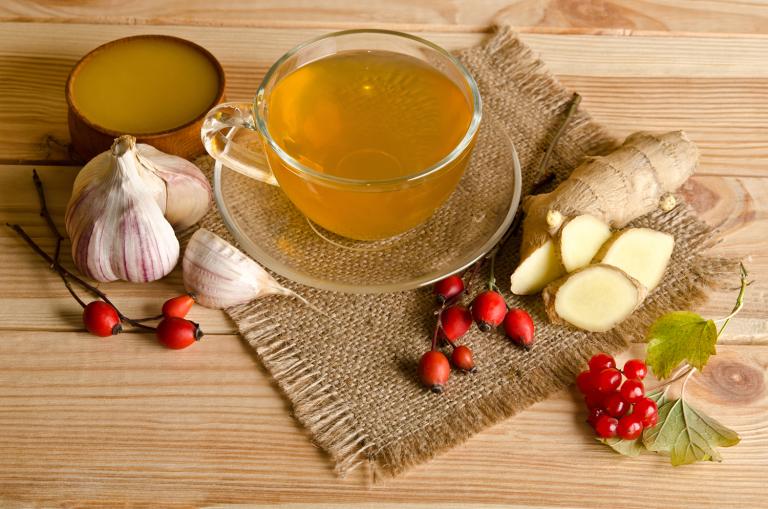How the Circulatory System Works
Your cardiovascular system is an intricate network of roadways. These passages allow for the delivery of oxygen, nutrients, hormones, and blood cells as well as the pick up and disposal of metabolic waste via the body’s detoxification systems.
Your heart keeps blood pumping through the circulatory system, but the blood vessels themselves—ranging from big central arteries to veins and tiny capillaries—are crucial to things running smoothly. When circulation begins to falter, you’re at a greater risk of conditions like varicose veins and life-threatening deep vein thrombosis, heart attack, and stroke. Fortunately, diet, lifestyle, herbs, and supplements can help keep your circulatory system strong, flexible, and functioning well.
Diet for Circulation Support
Above all else, a healthy diet, daily exercise (particularly cardio), avoidance of toxic chemicals, stress management, and adequate sleep form the backbone of a circulation-friendly routine. When it comes to diet, be sure to consume veggies and fruit (especially berries), high-fiber legumes, nuts, seeds, whole grains, cooked mushrooms, wild-caught, fatty coldwater fish, and healthy fats from olive oil and avocados. Enjoy antioxidant-rich dark chocolate/cacao, green tea, and red wine/purple grape juice as treats in moderation.
Supplements for The Cardiovascular System
These remedies support circulation and overall cardiovascular health by decreasing inflammation, fighting oxidative damage, strengthening the heart muscle, and/or thinning the blood. All these remedies are best taken daily long-term in substantial doses for the best results.
-
Hawthorn for Heart Health
Hawthorn (Crataegus spp.) berries, leaf, and flower have been used for thousands of years and are well studied for their gradual, cumulative, tonic effect on the heart and blood vessel lining.
Hawthorn decreases oxidative damage and inflammation, normalizes and reduces blood pressure, modestly reduces cholesterol, dilates blood vessels, improves oxygen utilization, reduces blood stickiness (also known as platelet aggregation), helps with healing from cardiovascular events, improves heart rhythm, reduces symptoms of congestive heart failure, and helps you achieve and maintain smooth blood vessel lining.
It’s exceedingly safe, but slow acting and may interact with some heart medications. High-potency products such as solid extract and standardized extracts work well.
-
Hibiscus Flowers & Rooibos for Cardiovascular Care
Hibiscus Flowers (Hibiscus sabdariffa) and rooibos (Aspalathus linearis), often consumed as tea, also offer antioxidant and anti-inflammatory action for the cardiovascular system.
Relatively large doses of hibiscus have performed as well as anti hyper-tension drugs including lisinopril, captopril, and hydrochlorothiazide. Consuming several cups per day helps lower blood pressure and cholesterol too.
-
Antioxidant Berries to Tone Your Blood Vessels
Blueberries (Vaccinium spp.) and other berries contain antioxidant, anti-inflammatory blue-purple pigments that, when consumed regularly, help tone blood vessel lining.
-
Garlic for Cholesterol and Blood Pressure Reduction
Garlic (Allium sativum) bulb benefits circulation in several ways. Alongside modest cholesterol and blood pressure reduction, garlic helps make the blood less sticky and thick by reducing platelet aggregation, atherosclerosis, inflammation, and fibrin—all of which are enemies of good circulation.
This blood thinner should not be combined with blood thinning medications without close medical supervision. Use it in food (chop and let sit 10 minutes) or pills. If you find garlic odor offensive or get digestive upset, try aged garlic extract.
-
Enhance Circulation with Garlic’s Friends
Other pungent food-herbs also enhance circulation and help keep blood flowing smoothly. These include onions (Allium cepa), ginger (Zingiber officinale), turmeric (Cucuma longa), hot peppers (Capsicum spp.), and rosemary (Rosmarinus officinale).
-
Mediate Blood Vessel Inflammation with Gotu Kola
Gotu kola (Centella asiatica) leaf focuses less on the heart directly and more on blood viscosity and blood vessel lining. It improves circulation, reduces vascular edema, mediates inflammation within the blood vessel lining, and improves the blood vessel lining integrity so that it’s smooth, flexible, and strong.
Several studies support gotu kola’s ability to manage circulatory conditions, especially vascular insufficiency and circulatory issues stemming from long stretches of sitting (such as with air travel).
Though it’s typically used for long-term benefits, one study found that taking a 60 milligram (mg) concentrated extract three times daily for two days prior to a flight, the day of, and the day after significantly reduced the negative vascular effects of flying. Relatively high doses (up to an ounce a day of the dried leaf) or concentrated extracts work best.
-
Tone and Tighten Blood Vessels with Yarrow
The wildflower yarrow (Achillea millefolium) tightens and tones blood vessels while improving blood flow. Use the leaves and flowers as a tincture or tea, but note that as a daisy-family flower, allergies are possible.

